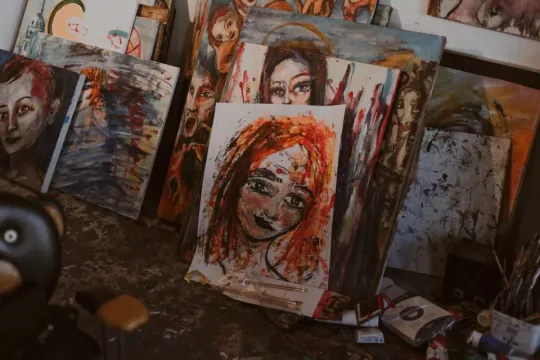Spanish painting

Spanish painting is all the pictorial production of this country from the first representations of the cave paintings of the Paleolithic, in particular in the cave of Altamira to contemporary art, of which one of the main figures is Pablo Picasso.
Indeed, in Spain, we find one of the masterpieces of Spanish painting of the Palaeolithic in the cave of Altamira. These paintings, discovered in 1879, are the first extensive prehistoric pictorial ensemble known today. Such a discovery determines that the study of the cave and its recognition raises a great controversy around the conceptions accepted in prehistoric science.
The realism of his scenes provoked, at the beginning, a debate around his authenticity. Its recognition as an artistic work produced by Paleolithic men is a long process that will help define studies on Prehistory.
The set of caves is currently recognized as a UNESCO World Heritage Site.
Gothic
Gothic painting in Spain developed in four phases.
In the Linear Gothic or Franco-Gothic style, there are stained glass windows, such as those in the cathedral of León. Wall frescoes have survived in some churches, as have table paintings. The miniaturist's work is remarkable, the masterpiece being the miniatures illustrating the codex of the Escurial des Cantigas.
During the Italogothic or Tercentist style (second half of the fourteenth century), the Sienese school was the most influential with the, in the same way as the Florentine school in the kingdom of Castile and Leone. During this phase, the Catalan painters are the most notable: Ferrer Bassa, Ramon Des torrents and the brothers Jaume, Joan and Pere Serra.
Entering the 15th century, Spain adhered to the international style with authors such as the Catalans Lluis Borrassà and Bernat Martorell as well as Dello di Niccolò Delli and Nicolás Francés (es) in Castile.
The Flemish style arrived in Spain around the middle of the 15th century with various regional schools: Lluís Dalmau and Jaume Huguet in Catalonia; Jaume Baçó Escrivà and Juan Rexach in Valencia; Bartolomé Bermejo in Aragon and Jorge Inglés (es) and Fernando Gallego in Castile.
Middle Ages
The Spanish Middle Ages is one of the richest in Europe, with the two great currents: Romanesque art and Gothic art.
Renaissance
Renaissance painting in Spain began in Valencia with the painters Fernando Yáñez de la Almedina and Hernando de los Llanos, influenced by Leonardo da Vinci, and by Juan de Juanes, influenced by Raphael.
Then appear in Castile the painters Juan de Flandes and Pedro Berruguete, while the son of the latter, Alonso Berruguete, is already a mannerist painter. The extreme Luis de Morales (1509-1586), called “el Divino” (“the Divine”) is also part of this movement. Also notable are Juan Correa de Vivar and Pedro Machuca in Toledo and Alejo Fernández in Andalusia.
At the time of Philip II, the Venetian influence marked Juan Fernández de Navarrete, called “el Mudo” (“the Mute”, 1526–1579). At his court, the portrait painter Alonso Sánchez Coello (1531–1588) and his disciples Juan Pantoja de la Cruz (1553–1608) stood out.
Romanesque art
In Spain, we know of no stained glass painted before the thirteenth century; on the other hand, several Romanesque wall paintings and other table paintings have been recorded since the 11th century, as well as codice miniatures of earlier dates. These miniatures continued to be produced during the twelfth century with little difference, except for a better technique of drawing and a reduction in the fantastical ornamentation, as can be observed in the book of the Testaments of the San Salvador Cathedral in Oviedo and in other codices of this century.
Baroque
The Baroque period represents the apogee of Spanish painting both in pictorial activity and in all the arts: it is thus known as the Spanish Golden Age. Baroque painting in Spain is characterized by still lifes and portraits, and by the large number of active and interesting artists. The greatest exponent of this movement is Diego Vélasquez, genius of light and darkness and the main portrait painter of the time; he is considered one of the very best painters, both of his time and of all time – he is sometimes defined as the “painter of painters”. »
Other painters from this period are notable, such as Bartolomé Esteban Murillo, who specialized in depicting his contemporary subjects with great realism.
The main representatives of religious painting are Francisco de Zurbarán and José de Ribera, authors of a great tenebrism, typical of the time.
El Greco and Pacheco
The two masters of the Spanish Renaissance are El Greco and Francisco Pacheco.
The first, whose real name is Domenico Theotocopuli, is from Crete but is considered a Spanish painter. He is the main representative of Spanish painting of the 16th century and of the entire Renaissance. He painted in Toledo, where he lived, his most important works.
The second is a mannerist and primitive baroque painter. He is the master of Diego Vélasquez ("the painter of painters") and the friend of El Greco.